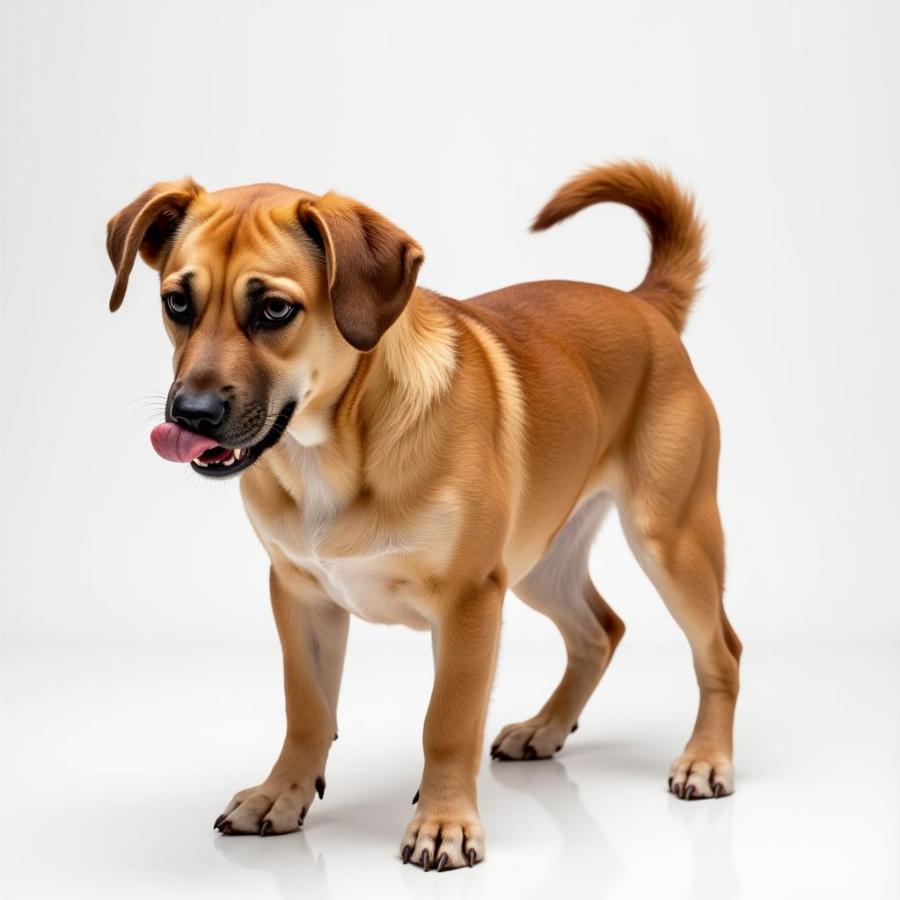Scary dog pictures can evoke a range of emotions, from fear and anxiety to fascination and even amusement. Understanding why certain dog images are perceived as scary and the impact they have on both people and dogs is crucial for responsible pet ownership and online engagement. This article will delve into the various factors contributing to the “scariness” of dog pictures, explore the potential implications, and offer guidance on navigating the online world of canine imagery responsibly.
Decoding the Fear Factor: What Makes a Dog Picture Scary?
Several elements can contribute to the perception of a dog picture as scary. Breed stereotypes, often fueled by media portrayals, play a significant role. Images showcasing aggressive postures, bared teeth, or intense stares can also trigger fear responses, even in breeds typically considered gentle. Context is key: a picture of a dog in a seemingly threatening situation, even if unintentional, can be interpreted as scary.
The Influence of Breed Stereotypes
Sadly, certain breeds are unfairly labeled as “scary” based on their appearance or historical roles. Breeds like Rottweilers, Pit Bulls, and Doberman Pinschers often face undue prejudice, with their images sometimes used to evoke fear or aggression, regardless of the individual dog’s temperament. It’s crucial to remember that every dog is an individual, and judging a dog based solely on breed is inaccurate and harmful.
Body Language and Postures
A dog’s body language speaks volumes. Pictures capturing defensive postures, such as flattened ears, tucked tails, and lip licking, can indicate fear or anxiety in the dog, which some viewers might misinterpret as aggression. Similarly, images of dogs displaying dominant behaviors like raised hackles or direct stares can appear intimidating.  Ngôn ngữ chó sợ hãi
Ngôn ngữ chó sợ hãi
The Impact of Scary Dog Pictures: Beyond the Initial Reaction
The proliferation of scary dog pictures online can have far-reaching consequences. These images can perpetuate negative stereotypes, fueling breed-specific legislation and discrimination. They can also contribute to fear and anxiety in individuals, particularly those with previous negative experiences with dogs. Furthermore, the misuse of such images can negatively impact dogs themselves, potentially leading to misunderstandings and even mistreatment.
Perpetuating Harmful Stereotypes
Sharing and promoting scary dog pictures without context reinforces harmful stereotypes. This can lead to unwarranted fear and prejudice against specific breeds, making it harder for responsible owners to navigate public spaces and access essential services like dog walkers or groomers.
Impact on Individuals with Cynophobia
For individuals with cynophobia (fear of dogs), scary dog pictures can trigger anxiety and panic attacks. Even seemingly innocuous images can exacerbate their fear, hindering their ability to interact with dogs and potentially impacting their quality of life.
Navigating the Online World of Dog Pictures Responsibly
We all have a role to play in promoting responsible online engagement with dog imagery. Sharing pictures of dogs showcasing positive behaviors and interactions helps counteract negative stereotypes. Providing context and accurate information alongside images is essential to avoid misinterpretations. Finally, reporting and challenging the misuse of scary dog pictures to promote fear or hatred is crucial for creating a safer and more inclusive online environment for both people and dogs.
Promoting Positive Imagery
Sharing pictures of dogs playing, cuddling, or engaging in other positive behaviors helps create a more balanced and realistic perception of dogs. This can help combat negative stereotypes and promote a more positive view of dogs in general.
Conclusion: Moving Beyond Scary Dog Pictures
Scary dog pictures can have a significant impact, influencing perceptions and perpetuating harmful stereotypes. By understanding the factors that contribute to the “scariness” of these images and their potential consequences, we can engage with online dog imagery more responsibly. Let’s strive to share positive, accurate, and contextualized representations of dogs, celebrating the wonderful bond between humans and their canine companions. Remember, behind every picture is a living being deserving of respect and understanding.
FAQs:
- Why are some people afraid of dogs? Fear of dogs, or cynophobia, can stem from various factors, including past negative experiences, learned behaviors, or genetic predispositions.
- How can I help counter negative stereotypes about certain dog breeds? Sharing positive images and stories of these breeds, educating others about responsible dog ownership, and challenging misinformation are all effective ways to counter negative stereotypes.
- Is it ever appropriate to share a picture of a dog that looks scary? It depends on the context. If the picture is used to educate about dog body language or to raise awareness about responsible dog handling, it might be appropriate. However, sharing images solely to evoke fear or perpetuate stereotypes is never acceptable.
- What should I do if I see a scary dog picture being used to promote hatred or discrimination? Report the image to the platform where it was shared and consider challenging the poster’s views in a respectful and informative manner.
- How can I find positive and accurate information about different dog breeds? Reputable breed-specific rescue organizations, kennel clubs, and veterinary websites are excellent sources of information.